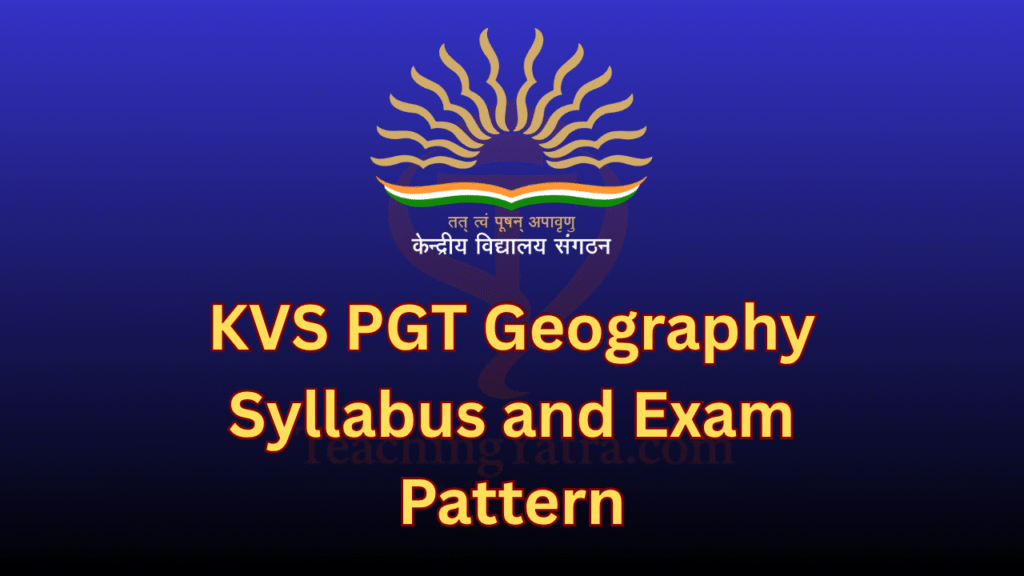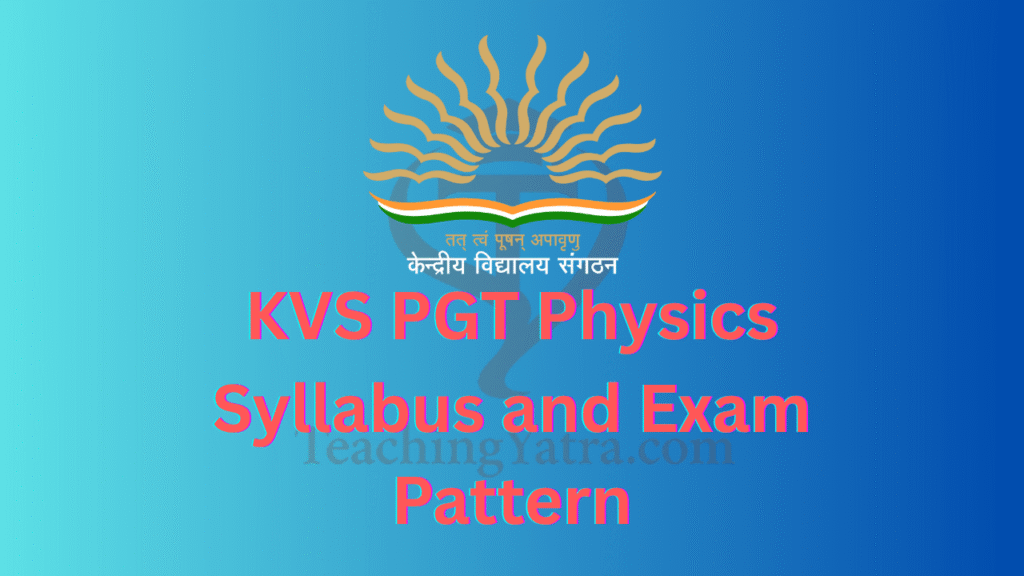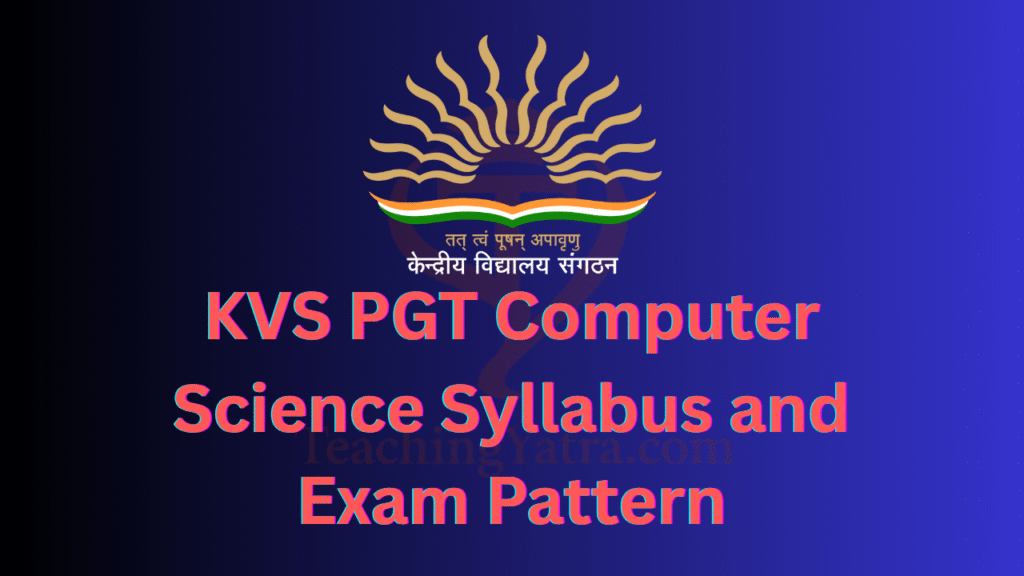
Get the complete KVS PGT Geography Syllabus 2025, covering essential topics in Physical and Human Geography, Indian Geography, Cartography, and more. Strengthen your preparation with the latest syllabus for the Kendriya Vidyalaya PGT Geography exam. Download the PDF and explore topic-wise details to plan your study effectively.
Table of Contents
KVS PGT Geography Syllabus: Overview
Candidates preparing for the KVS PGT Geography Exam 2025 should begin their preparation by thoroughly reviewing the officially released syllabus, available on the Kendriya Vidyalaya Sangathan (KVS) website. To increase their chances of selection in the KVS Teacher Recruitment 2025, aspirants are advised to download the detailed syllabus PDF and follow a structured, topic-wise preparation plan. A solid understanding of the syllabus will help focus on important subjects, manage time efficiently, and boost overall confidence for the Geography PGT post.
The KVS PGT Geography Syllabus 2025 outlines the key subjects and topics that candidates need to study for the recruitment exam conducted by Kendriya Vidyalaya Sangathan (KVS). To prepare effectively, aspirants must stay updated with official notifications and thoroughly review the latest syllabus. A focused, well-planned study strategy based on the syllabus will enhance performance and improve the chances of securing the PGT Geography post.
KVS PGT Geography Exam Pattern 2025
Understanding the KVS PGT Geography exam pattern is essential for smart and strategic preparation. It helps candidates understand the number of questions, marking scheme, duration, and structure of the exam. The paper is conducted in bilingual mode (English & Hindi) and includes objective-type multiple-choice questions.
KVS PGT Geography 2025: Marks Distribution
The exam is divided into four major parts with seven sub-sections:
| Part | Subjects | No. of Questions | Marks |
|---|---|---|---|
| Part I | General English | 10 | 10 |
| General Hindi | 10 | 10 | |
| Part II | General Awareness & Current Affairs | 10 | 10 |
| Reasoning Ability | 5 | 5 | |
| Computer Literacy | 5 | 5 | |
| Part III | Perspectives on Education and Leadership | 40 | 40 |
| Part IV | Geography (Subject Concerned) | 100 | 100 |
| Total | 180 | 180 |
Detailed KVS PGT Geography Syllabus 2025
Subject specific syllabus includes the concepts of NCERT/CBSE syllabus and Text Books (Classes XI & XII), however, the questions will be testing the depth of understanding and application of these concepts at the level of Post-Graduation.
Geography as a Discipline
• Geography as an integrating discipline, as a science of spatial attributes
• Branches of Geography: Physical Geography and Human Geography
The Earth
• Origin and evolution of the earth
• Interior of the earth; Earthquakes and volcanoes: causes, types and effects
• Distribution of oceans and continents: Wegener’s continental drift theory and plate tectonics
Landforms
• Geomorphic processes: weathering, mass wasting, erosion and deposition, soil formation
• Landforms and their evolution – Brief erosional and depositional features
Climate
• Atmosphere – composition and structure; elements of weather and climate
• Solar Radiation – Insolation, angle of incidence and distribution; heat budget of the earth; heating and cooling of atmosphere (conduction, convection, terrestrial radiation and advection); temperature – factors controlling temperature; distribution of temperature – horizontal and vertical; inversion of temperature
• Atmospheric circulation and weather systems – Pressure belts; winds – planetary, seasonal and local; air masses and fronts; tropical and extra tropical cyclones
• Water in the atmosphere – Precipitation, evaporation, condensation – dew, frost, fog, mist and cloud; rainfall – types and world distribution
• World Climate and Global Concerns
Water (Oceans)
• Basics of Oceanography
• Oceans – distribution of temperature and salinity
• Movements of ocean water – waves, tides and currents; submarine reliefs
Life on the Earth
• Biosphere – importance of plants and other organisms; biodiversity and conservation
India – Physical Environment
• India: Location, space relations, India’s place in the world
Physiography
• Structure and Relief; Physiographic Divisions
• Drainage systems: Concept of river basins, watershed; the Himalayan and the Peninsular rivers
Climate, Vegetation and Soil
• Weather and climate – spatial and temporal distribution of temperature; Indian monsoon: mechanism, onset and withdrawal
• Natural vegetation – forest types and distribution; wildlife; conservation; biosphere reserves
Hazards and Disasters: Causes, Consequences and Management
• Floods, Cloudbursts
• Droughts – types and impact
• Earthquakes and Tsunami; Cyclones – features and impact
• Landslides
Fundamentals of Maps
• Geo-spatial data, Concept of Geographical data matrix; Point, line, area data
• Maps – types; scales – types; construction of simple linear scale, measuring distance; finding direction and use of symbols
• Map projection – Latitude, longitude and time, typology, construction and properties of projection: Conical with one standard parallel and Mercator’s projection
Topographic and Weather Maps
• Study of topographic maps (1:50,000 or 1:25,000 Survey of India maps); contour cross section and identification of landforms – slopes, hills, valleys, waterfall, cliffs; distribution of settlements
• Satellite imageries, stages in remote sensing data – acquisition, platform and sensors and data products (photographic and digital)
People
• The World Population – distribution, density and growth
• Population change – Components of population change, Demographic Transition
• Human development – concept; selected indicators, international comparisons
• Population – distribution, density and growth; composition of population – linguistic, religious, sex, rural-urban and occupational; regional variations in population growth
Human Activities
• Primary activities – concept and changing trends; gathering, pastoral, mining, subsistence agriculture, modern agriculture; people engaged in agricultural and allied activities – examples from selected countries
• Secondary activities – concept; manufacturing: types – household, small scale, large scale; agro-based and mineral-based industries
• Tertiary activities – concept; trade, transport and tourism; services; people engaged in tertiary activities
• Quaternary activities – concept; people engaged in quaternary activities – case study from selected countries
Human Settlements
• Rural settlements – types and distribution
• Urban settlements – types, distribution and functional classification
Transport, Communication and Trade
• Land transport – roads, railways; trans-continental railways
• Water transport – inland waterways; major ocean routes
• Air transport – intercontinental air routes; oil and gas pipelines
• Satellite communication and cyber space – importance and usage for geographical information; use of GPS
• International trade – bases and changing patterns; ports as gateways of international trade; role of WTO in international trade
Resources and Development
• Land resources – general land use; agricultural land use; geographical conditions and distribution of major crops (Wheat, Rice, Tea, Coffee, Cotton, Jute, Sugarcane and Rubber); agricultural development and problems
• Water resources – availability and utilization – irrigation, domestic, industrial and other uses; scarcity of water and conservation methods – rainwater harvesting and watershed management
• Mineral and energy resources – distribution of metallic (Iron ore, Copper, Bauxite, Manganese); non-metallic (Mica, Salt) minerals; conventional (Coal, Petroleum, Natural Gas and Hydroelectricity) and non-conventional energy sources (solar, wind, biogas) and conservation
• Planning in India – target group area planning (case study); idea of sustainable development (case study)
Transport, Communication and International Trade
• Transport and communication – roads, railways, waterways and airways; oil and gas pipelines; geographical information and communication networks
• International trade – changing pattern of India’s foreign trade; sea ports and their hinterland and airports
Geographical Perspective on Selected Issues and Problems
• Environmental pollution; urban waste disposal
• Urbanization, rural-urban migration; problems of slums
• Land degradation
Detailed KVS PGT Geography Syllabus 2025 in Hindi
भूगोल एक विषय के रूप में
- भूगोल एक समेकित विषय के रूप में, स्थानिक विशेषताओं का विज्ञान
- भूगोल की शाखाएं: भौतिक भूगोल और मानव भूगोल
पृथ्वी
- पृथ्वी की उत्पत्ति और विकास
- पृथ्वी की आंतरिक संरचना; भूकंप और ज्वालामुखी: कारण, प्रकार और प्रभाव
- महासागरों और महाद्वीपों का वितरण: वेगनर का महाद्वीप विचलन सिद्धांत और प्लेट विवर्तनिकी
स्थलरूप
- भू-आकृतिक प्रक्रियाएं: अपक्षय, भूस्खलन, अपरदन और निक्षेपण, मृदा निर्माण
- स्थलरूप और उनका विकास
जलवायु
- वायुमंडल: संघटन, संरचना, मौसम और जलवायु
- सौर विकिरण, तापमान वितरण, ताप और शीत प्रक्रिया
- वायुमंडलीय परिसंचरण, दाब पट्टियाँ, पवनें, चक्रवात
- वायुमंडल में जल: वाष्पीकरण, संघनन, वर्षा
- विश्व जलवायु और वैश्विक मुद्दे
जल (महासागर)
- समुद्र विज्ञान की मूल बातें
- महासागर का तापमान, लवणता, लहरें, ज्वार, समुद्री धाराएँ
- समुद्र तल की स्थलाकृति
पृथ्वी पर जीवन
- जीवमंडल, जैव विविधता और संरक्षण
भारत – भौतिक पर्यावरण
- भारत का स्थान और अंतरिक्षीय संबंध
- संरचना और भौगोलिक विभाजन
- नदियों की प्रणालियाँ
जलवायु, वनस्पति और मृदा
- मानसून, तापमान, वनस्पति प्रकार और वन्य जीव
आपदाएं और जोखिम
- बाढ़, सूखा, चक्रवात, भूस्खलन
मानचित्र के मूल सिद्धांत
- भू-स्थानिक आंकड़े, मानचित्र प्रकार और प्रक्षेप
स्थलाकृतिक एवं मौसम मानचित्र
- स्थलाकृतिक मानचित्र, समोच्च रेखाएं, रिमोट सेंसिंग
जनसंख्या
- जनसंख्या का वितरण, वृद्धि, मानव विकास
मानव गतिविधियाँ
- प्राथमिक, द्वितीयक, तृतीयक, चतुर्थक गतिविधियाँ
मानव बस्तियाँ
- ग्रामीण और शहरी बस्तियाँ
परिवहन, संचार और व्यापार
- सड़कें, रेलमार्ग, जलमार्ग, वायुमार्ग, GPS
संसाधन और विकास
- भूमि, जल, खनिज, ऊर्जा संसाधन
- सतत विकास और नियोजन
चयनित मुद्दों पर भौगोलिक दृष्टिकोण
- प्रदूषण, प्रवासन, नगरीकरण, झुग्गियाँ, भूमि क्षरण
Detailed KVS PGT Geography Syllabus 2025 PDF
| KVS PGT Geography Syllabus 2025 | |
| KVS PGT Syllabus 2025 (General Paper) | Click Here |
| KVS PGT Geography Syllabus 2025 | Click Here |

